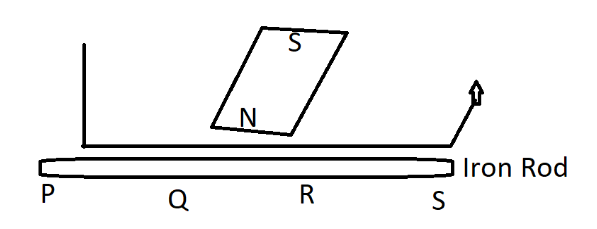
Answer
360.3k+ views
Hint:The magnetic impact on moving electric charges, electric currents, and magnetic materials is described by a magnetic field, which is a vector field. In a magnetic field, a moving charge experiences a force that is perpendicular to both its own velocity and the magnetic field.
Complete answer:
Magnetization is the vector field in classical electromagnetism that expresses the density of permanent or induced magnetic dipole moments in a magnetic substance. The direction of movement within this area is classified as either Axial or Diametric. The magnetic moments that cause magnetization can be caused by small electric currents caused by electron mobility in atoms, or by the spin of the electrons or nuclei. The response of a substance to an external magnetic field produces net magnetization.
Procedure:
-The steel bar is stroked in one direction from one end to the other with the same pole of the permanent magnet.
-Between strokes, the stroking magnet must be elevated sufficiently enough above the steel bar.
-Because the atomic magnets in the domain are attracted to the stroking pole, the steel bar will become a magnet with a pole formed at the end where the strokes cease, which is opposed to the stroking pole.
-When employing two magnets, the stroking poles of each magnet must be opposed, and the steel bar must be stroked in the opposite way.
-Stoking with two magnets is faster than with one magnet.
-The striking approach creates only weak magnets.
-As a result, Q becomes the North pole, and R becomes the South pole, where the rubbing magnet is raised.
Hence option B is correct.
Note:The term "demagnetization" refers to the process of reducing or eliminating magnetism. One method is to heat the item over its Curie temperature, at which point thermal fluctuations have sufficient energy to overcome exchange interactions, the source of ferromagnetic order, and destroy it. Another method is to pull it out of an electric coil that has alternating current running through it, creating fields that fight magnetization.
Complete answer:
Magnetization is the vector field in classical electromagnetism that expresses the density of permanent or induced magnetic dipole moments in a magnetic substance. The direction of movement within this area is classified as either Axial or Diametric. The magnetic moments that cause magnetization can be caused by small electric currents caused by electron mobility in atoms, or by the spin of the electrons or nuclei. The response of a substance to an external magnetic field produces net magnetization.
Procedure:
-The steel bar is stroked in one direction from one end to the other with the same pole of the permanent magnet.
-Between strokes, the stroking magnet must be elevated sufficiently enough above the steel bar.
-Because the atomic magnets in the domain are attracted to the stroking pole, the steel bar will become a magnet with a pole formed at the end where the strokes cease, which is opposed to the stroking pole.
-When employing two magnets, the stroking poles of each magnet must be opposed, and the steel bar must be stroked in the opposite way.
-Stoking with two magnets is faster than with one magnet.
-The striking approach creates only weak magnets.
-As a result, Q becomes the North pole, and R becomes the South pole, where the rubbing magnet is raised.
Hence option B is correct.
Note:The term "demagnetization" refers to the process of reducing or eliminating magnetism. One method is to heat the item over its Curie temperature, at which point thermal fluctuations have sufficient energy to overcome exchange interactions, the source of ferromagnetic order, and destroy it. Another method is to pull it out of an electric coil that has alternating current running through it, creating fields that fight magnetization.
Recently Updated Pages
How many sigma and pi bonds are present in HCequiv class 11 chemistry CBSE

Mark and label the given geoinformation on the outline class 11 social science CBSE

When people say No pun intended what does that mea class 8 english CBSE

Name the states which share their boundary with Indias class 9 social science CBSE

Give an account of the Northern Plains of India class 9 social science CBSE

Change the following sentences into negative and interrogative class 10 english CBSE

Trending doubts
Difference Between Plant Cell and Animal Cell

Difference between Prokaryotic cell and Eukaryotic class 11 biology CBSE

Fill the blanks with the suitable prepositions 1 The class 9 english CBSE

Differentiate between homogeneous and heterogeneous class 12 chemistry CBSE

Which are the Top 10 Largest Countries of the World?

One cusec is equal to how many liters class 8 maths CBSE

Give 10 examples for herbs , shrubs , climbers , creepers

The mountain range which stretches from Gujarat in class 10 social science CBSE

The Equation xxx + 2 is Satisfied when x is Equal to Class 10 Maths




